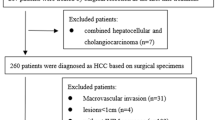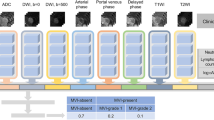Abstract
Objectives
We aimed to develop and validate a deep convolutional neural network (DCNN) model for preoperative prediction of microvascular invasion (MVI) in hepatocellular carcinoma (HCC) and its clinical outcomes using contrast-enhanced computed tomography (CECT) in a large population of candidates for surgery.
Methods
This retrospective study included 1116 patients with HCC who had undergone preoperative CECT and curative hepatectomy. Radiological (R), DCNN, and combined nomograms were constructed in a training cohort (n = 892) respectively based on clinicoradiological factors, DCNN probabilities, and all factors; the performance of each model was confirmed in a validation cohort (n = 244). Accuracy and the AUC to predict MVI were calculated. Disease-free survival (DFS) and overall survival (OS) after surgery were recorded.
Results
The proportion of MVI-positive patients was respectively 38.8% (346/892) and 35.7 % (87/244) in the training and validation cohorts. The AUCs of the R, DCNN, and combined nomograms were respectively 0.809, 0.929, and 0.940 in the training cohorts and 0.837, 0.865, and 0.897 in the validation cohort. The combined nomogram outperformed the R nomogram in the training (p < 0.001) and validation (p = 0.009) cohorts. There was a significant difference in DFS and OS between the R, DCNN, and combined nomogram-predicted groups with and without MVI (p < 0.001).
Conclusions
The combined nomogram based on preoperative CECT performs well for preoperative prediction of MVI and outcome.
Key Points
• A combined nomogram based on clinical information, preoperative CECT, and DCNN can predict MVI and clinical outcomes of patients with HCC.
• DCNN provides added diagnostic ability to predict MVI.
• The AUCs of the combined nomogram are 0.940 and 0.897 in the training and validation cohorts, respectively.





Similar content being viewed by others
Abbreviations
- DCNN:
-
Deep convolutional neural network
- DFS:
-
Disease-free survival
- EPAP:
-
Enhancement pattern in the arterial phase
- IDI:
-
Integrated discrimination improvement
- MVI:
-
Microvascular invasion
- NRI:
-
Net reclassification improvement
- OS:
-
Overall survival
- R:
-
Radiological
- RVI:
-
Radiogenomic venous invasion
References
Marrero JA, Kulik LM, Sirlin CB et al (2018) Diagnosis, staging, and management of hepatocellular carcinoma: 2018 practice guidance by the American Association for the Study of Liver Diseases. Hepatology 68:723–750
Zhou J, Sun HC, Wang Z et al (2018) Guidelines for diagnosis and treatment of primary liver cancer in China (2017 edition). Liver Cancer 7:235–260
Cai W, He B, Hu M et al (2019) A radiomics-based nomogram for the preoperative prediction of posthepatectomy liver failure in patients with hepatocellular carcinoma. Surg Oncol 28:78–85
Imamura H, Matsuyama Y, Tanaka E et al (2003) Risk factors contributing to early and late phase intrahepatic recurrence of hepatocellular carcinoma after hepatectomy. J Hepatol 38:200–207
Lim KC, Chow PK, Allen JC et al (2011) Microvascular invasion is a better predictor of tumor recurrence and overall survival following surgical resection for hepatocellular carcinoma compared to the Milan criteria. Ann Surg 254:108–113
Sumie S, Kuromatsu R, Okuda K et al (2008) Microvascular invasion in patients with hepatocellular carcinoma and its predictable clinicopathological factors. Ann Surg Oncol 15:1375–1382
Chou CT, Chen RC, Lee CW, Ko CJ, Wu HK, Chen YL (2012) Prediction of microvascular invasion of hepatocellular carcinoma by pre-operative CT imaging. Br J Radiol 85:778–783
Zhao H, Hua Y, Dai T et al (2017) Development and validation of a novel predictive scoring model for microvascular invasion in patients with hepatocellular carcinoma. Eur J Radiol 88:32–40
Lee S, Kim SH, Lee JE, Sinn DH, Park CK (2017) Preoperative gadoxetic acid-enhanced MRI for predicting microvascular invasion in patients with single hepatocellular carcinoma. J Hepatol 67:526–534
Li H, Zhang J, Zheng Z et al (2018) Preoperative histogram analysis of intravoxel incoherent motion (IVIM) for predicting microvascular invasion in patients with single hepatocellular carcinoma. Eur J Radiol 105:65–71
Wang WT, Yang L, Yang ZX et al (2018) Assessment of microvascular invasion of hepatocellular carcinoma with diffusion kurtosis imaging. Radiology 286:571–580
Cao L, Chen J, Duan T et al (2019) Diffusion kurtosis imaging (DKI) of hepatocellular carcinoma: correlation with microvascular invasion and histologic grade. Quant Imaging Med Surg 9:590–602
Bi WL, Hosny A, Schabath MB et al (2019) Artificial intelligence in cancer imaging: clinical challenges and applications. CA Cancer J Clin 69:127–157
Hosny A, Parmar C, Quackenbush J, Schwartz LH, Aerts H (2018) Artificial intelligence in radiology. Nat Rev Cancer 18:500–510
Chilamkurthy S, Ghosh R, Tanamala S et al (2018) Deep learning algorithms for detection of critical findings in head CT scans: a retrospective study. Lancet 392:2388–2396
Li X, Zhang S, Zhang Q et al (2019) Diagnosis of thyroid cancer using deep convolutional neural network models applied to sonographic images: a retrospective, multicohort, diagnostic study. Lancet Oncol 20:193–201
Wang K, Lu X, Zhou H et al (2019) Deep learning radiomics of shear wave elastography significantly improved diagnostic performance for assessing liver fibrosis in chronic hepatitis B: a prospective multicentre study. Gut 68:729–741
Zhao K, Li Z, Yao S et al (2020) Artificial intelligence quantified tumour-stroma ratio is an independent predictor for overall survival in resectable colorectal cancer. EBioMedicine 61:103054
Zhang B, Yu K, Ning Z et al (2020) Deep learning of lumbar spine X-ray for osteopenia and osteoporosis screening: a multicenter retrospective cohort study. Bone 140:115561
Feng ST, Jia Y, Liao B et al (2019) Preoperative prediction of microvascular invasion in hepatocellular cancer: a radiomics model using Gd-EOB-DTPA-enhanced MRI. Eur Radiol 29:4648–4659
Xu X, Zhang HL, Liu QP et al (2019) Radiomic analysis of contrast-enhanced CT predicts microvascular invasion and outcome in hepatocellular carcinoma. J Hepatol 70:1133–1144
Zheng J, Chakraborty J, Chapman WC et al (2017) Preoperative prediction of microvascular invasion in hepatocellular carcinoma using quantitative image analysis. J Am Coll Surg 225(778-788):e771
Peng J, Zhang J, Zhang Q, Xu Y, Zhou J, Liu L (2018) A radiomics nomogram for preoperative prediction of microvascular invasion risk in hepatitis B virus-related hepatocellular carcinoma. Diagn Interv Radiol 24:121–127
Ma X, Wei J, Gu D et al (2019) Preoperative radiomics nomogram for microvascular invasion prediction in hepatocellular carcinoma using contrast-enhanced CT. Eur Radiol 29:3595–3605
Yang L, Gu D, Wei J et al (2019) A radiomics nomogram for preoperative prediction of microvascular invasion in hepatocellular carcinoma. Liver Cancer 8:373–386
Finn RS, Zhu AX, Farah W et al (2018) Therapies for advanced stage hepatocellular carcinoma with macrovascular invasion or metastatic disease: a systematic review and meta-analysis. Hepatology 67:422–435
An C, Kim DW, Park YN, Chung YE, Rhee H, Kim MJ (2015) Single hepatocellular carcinoma: preoperative MR imaging to predict early recurrence after curative resection. Radiology 276:433–443
Segal E, Sirlin CB, Ooi C et al (2007) Decoding global gene expression programs in liver cancer by noninvasive imaging. Nat Biotechnol 25:675–680
Banerjee S, Wang DS, Kim HJ et al (2015) A computed tomography radiogenomic biomarker predicts microvascular invasion and clinical outcomes in hepatocellular carcinoma. Hepatology 62:792–800
Renzulli M, Brocchi S, Cucchetti A et al (2016) Can current preoperative imaging be used to detect microvascular invasion of hepatocellular carcinoma? Radiology 279:432–442
Zhang R, Xu L, Wen X et al (2019) A nomogram based on bi-regional radiomics features from multimodal magnetic resonance imaging for preoperative prediction of microvascular invasion in hepatocellular carcinoma. Quant Imaging Med Surg 9:1503–1515
He L, Huang Y, Ma Z, Liang C, Liang C, Liu Z (2016) Effects of contrast-enhancement, reconstruction slice thickness and convolution kernel on the diagnostic performance of radiomics signature in solitary pulmonary nodule. Sci Rep 6:34921
Fave X, Cook M, Frederick A et al (2015) Preliminary investigation into sources of uncertainty in quantitative imaging features. Comput Med Imaging Graph 44:54–61
Orlhac F, Frouin F, Nioche C, Ayache N, Buvat I (2019) Validation of a method to compensate multicenter effects affecting CT radiomics. Radiology 291:53–59
Roayaie S, Blume IN, Thung SN et al (2009) A system of classifying microvascular invasion to predict outcome after resection in patients with hepatocellular carcinoma. Gastroenterology 137:850–855
Nitta H, Allard MA, Sebagh M et al (2019) Predictive model for microvascular invasion of hepatocellular carcinoma among candidates for either hepatic resection or liver transplantation. Surgery 165:1168–1175
Lei Z, Li J, Wu D et al (2016) Nomogram for preoperative estimation of microvascular invasion risk in hepatitis B virus-related hepatocellular carcinoma within the Milan criteria. JAMA Surg 151:356–363
Hsu CC, Goyal A, Iuga A et al (2015) Elevated CA19-9 is associated with increased mortality in a prospective cohort of hepatocellular carcinoma patients. Clin Transl Gastroenterol 6:e74
Acknowledgements
We thank Dr. Peihua Cao in Zhujiang Hospital, Southern Medical University, for his help in statistics.
Funding
This work was funded by Guangdong Basic and Applied Basic Research Foundation (2019A1515011269, 2021A1515011305), Clinical Research Startup Program of Southern Medical University by High-Level University Construction Funding of Guangdong Provincial Department of Education (LC2016PY034), and Opening Research Fund of Guangzhou Key Laboratory of Molecular and Functional Imaging for Clinical Translation (201905010003).
Author information
Authors and Affiliations
Corresponding authors
Ethics declarations
Guarantor
The scientific guarantor of this publication is Xianyue Quan.
Conflict of interest
The authors have declared that no competing interest exists.
Statistics and biometry
Two of the authors (Xinming Li and Xianyue Quan) have significant statistical expertise. We thank Dr. Peihua Cao of Zhujiang Hospital, Southern Medical University, for his help in statistics.
Informed consent
Written informed consent was waived by the institutional review board.
Ethical approval
Institutional review board approval was obtained.
Methodology
• retrospective
• diagnostic or prognostic study
• multicenter study
Additional information
Publisher’s note
Springer Nature remains neutral with regard to jurisdictional claims in published maps and institutional affiliations.
Supplementary Information
ESM 1
(DOCX 6.65 mb)
Rights and permissions
About this article
Cite this article
Li, X., Qi, Z., Du, H. et al. Deep convolutional neural network for preoperative prediction of microvascular invasion and clinical outcomes in patients with HCCs. Eur Radiol 32, 771–782 (2022). https://doi.org/10.1007/s00330-021-08198-w
Received:
Revised:
Accepted:
Published:
Issue Date:
DOI: https://doi.org/10.1007/s00330-021-08198-w




